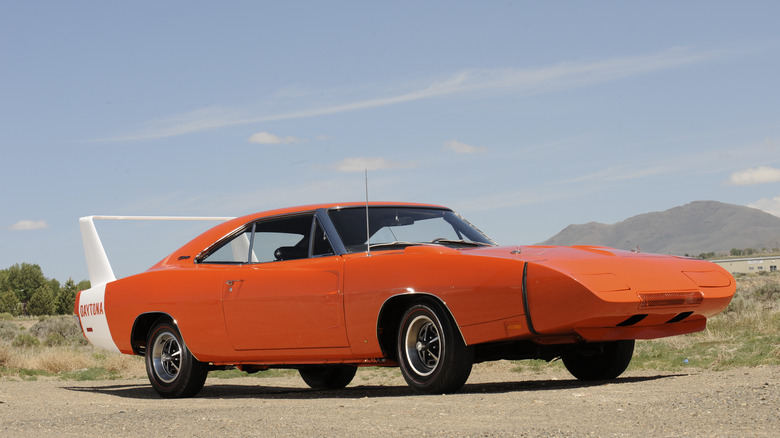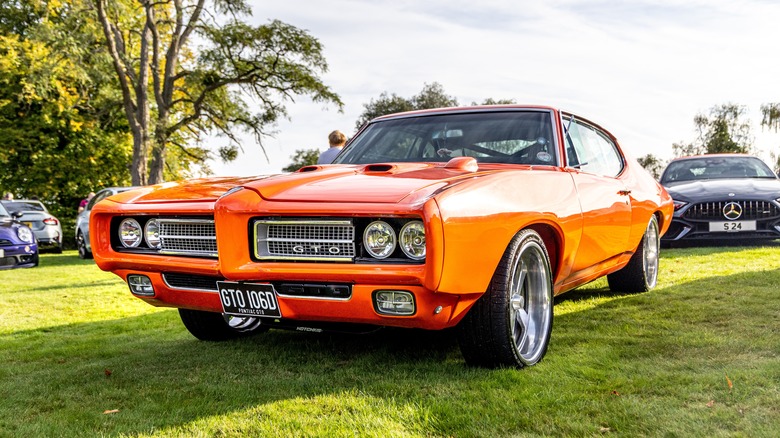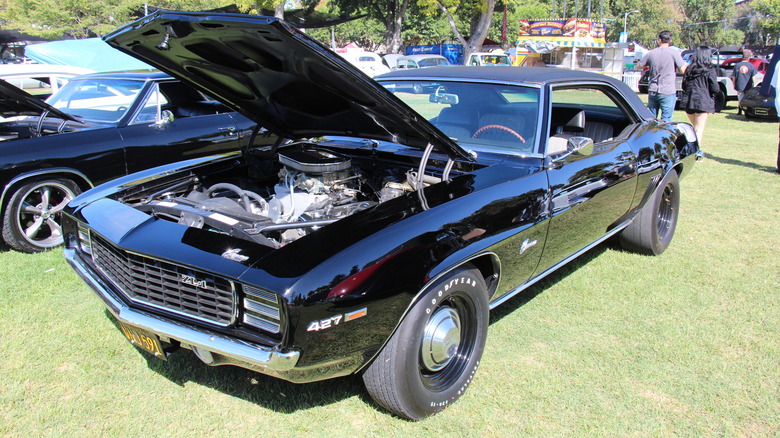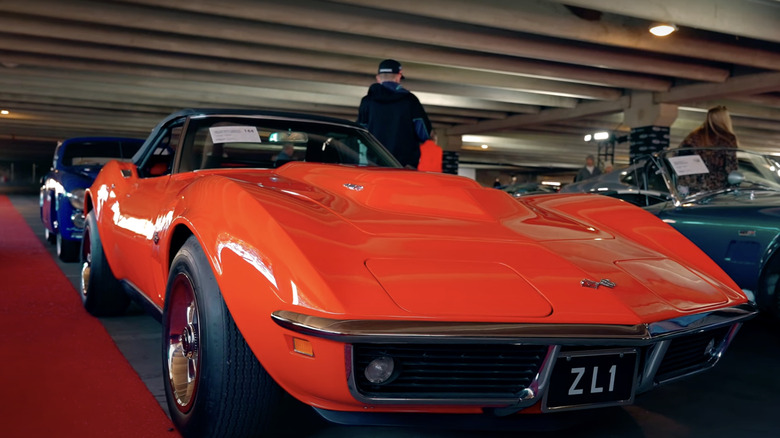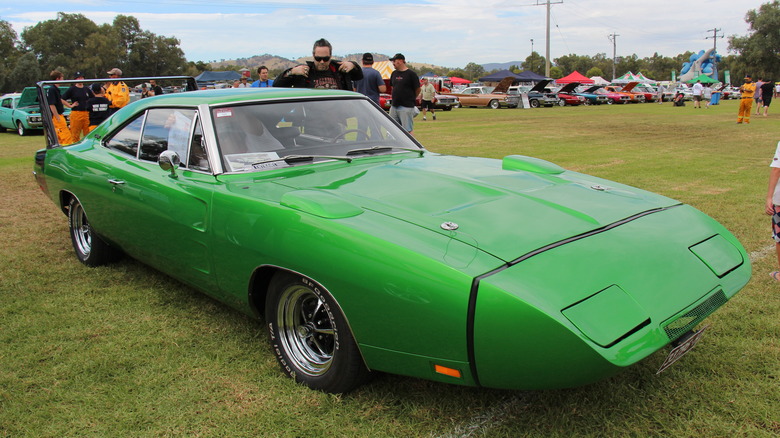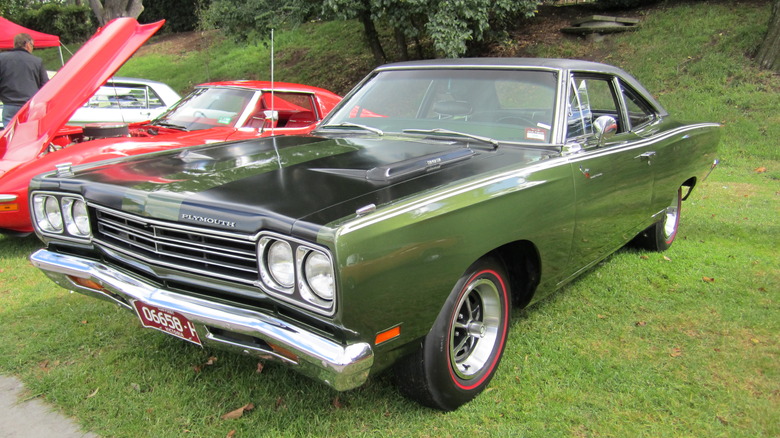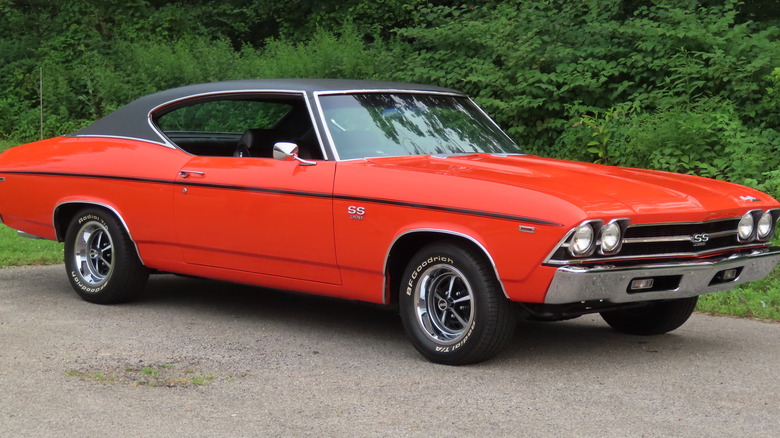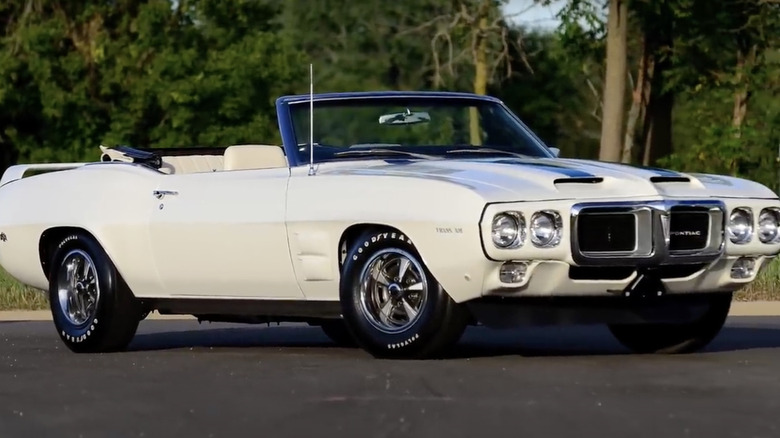The 7 Coolest Muscle Cars Of 1969
1969 was a watershed year in American history, both on Earth and in space. Richard Nixon was sworn in as President in January, Neil Armstrong landed on the moon in July, and the Woodstock music festival drew 400,000 people to Max Yasgur's farm in Bethel, New York in August. Of course, 1969 was also a huge year for the American-made muscle car.
The muscle car era was reaching its peak ahead of the 1973 oil crisis and the fuel economy and emissions standards that would emerge soon afterwards. By the mid-1970s, large, heavy, V8-powered muscle cars were an anachronism, but in 1969, drive-in movie theaters and weekend dragstrips were packed end-to-end with monstrous, gas-guzzling beasts. We easily could have filled this list with a dozen cars or more, but we pared it down to a lucky seven models for the sake of digestibility. These are the coolest muscle cars from 1969.
The Pontiac GTO Judge was a special edition of a special model
To start off our rundown of 1969's automotive highlights, "Here comes the Judge." That was the catchphrase for a character Sammy Davis, Jr. played on "Rowan & Martin's Laugh-In," and Pontiac chief engineer John DeLorean was reportedly a fan of the show. He had developed the GTO as a muscle car pioneer in 1964 and envisioned the Judge as a rival to the Plymouth Road Runner.
The first 2,000 GTO Judges were made in Carousel Red, a color that appeared bright orange to most eyes. Almost 5,000 followed in other colors, including white, black, and three shades of green. The Judge had a blacked-out grille and special graphics that included a tapered stripe running from just behind the headlights almost to the B-pillars, "The Judge" in a psychedelic font on the front fenders and rear spoiler, and Ram Air III labeling on the hood scoops for models so equipped.
According to Hemmings, Pontiac built 108 1969 Judge convertibles and 6,725 hardtops. The Judge came with a 400-cubic-inch V8 topped with a Ram Air III or IV system, and transmission options included three and four-speed manuals and the TH400 automatic. The Ram Air IV package included a Safe-T-Track limited slip rear differential with a 3.90:1 or 4.33:1 gear ratio. The rarest combination of the above features was a convertible with the Ram Air IV package and a manual transmission; only five were built in 1969.
The 1969 ZL-1 COPO Camaro is a rare legend
The 1969 GTO Judge was special, but it wasn't COPO Camaro special. COPO stands for Central Office Production Order, and the system was put in place for dealers who needed to obtain vehicles in special configurations for the likes of taxi services or law enforcement. Fred Gibb, who owned a dealership in Illinois and raced drag cars on the weekends, had other ideas for the COPO system. In 1968, he ordered 50 Chevy Novas with 396-cubic-inch V8s, and the next year he got extra creative.
Gibb ordered a few dozen 1969 Camaros with the 9560 package, which included a NASCAR-spec ZL-1 V8. That engine had an aluminum block and heads that shed about 100 pounds versus the Camaro's standard 396-cubic-inch V8, and its official output estimate of 430 horsepower is thought to be a vast underestimation.
Gibb was reportedly only able to sell 13 of the 50 COPO Camaros he ordered and had to offload the rest to other dealers. Chevy built 69 in all, with many of them going right to the National Hot Rod Association's Super Stock series for competition. They're among the most coveted classics on the market today, routinely fetching six figures.
[Featured image by Sicnag via Wikimedia Commons|Cropped and scaled|CC-By 2.0]
The '69 Corvette also came with the ZL-1 engine
The Corvette straddles the line between muscle car and sports car, but when it comes to the 1969 Stingray ZL-1, we feel it belongs in the former category. The option was offered beginning mid-year, but the fact that it added more than $4,718 to the $4,781 base cost of a Corvette made it a rare choice for buyers. With all necessary options tallied, the total cost was over $10,000, or more than $86,000 today, and only two 'Vettes left the factory with this engine option. The model was created by Chevy to meet homologation requirements for the FIA and NHRA and was not initially intended for public sale.
The ZL-1's officially reported output of 430 horsepower and 450 pound-feet blew away the base 'Vette's numbers of 300 horses and 300-pound feet, and the ZL-1 version was capable of a four-second 0-60 sprint and a quarter-mile run of 12.1 seconds at 116 miles per hour. The only 1969 ZL-1 convertible ever made went to Pennsylvanian John Maher, who blew the engine while racing it in local competition. Chevy provided a new short block, and Maher held on to the car until 2007. It was restored by its new owner, and Sotheby's auctioned it off last year for a little over $3 million.
The Dodge Charger Daytona looked like a rocket on wheels
Perhaps the coolest model of the year from a visual perspective was the Dodge Charger Daytona, which had a sharp nose cone and a huge rear wing that made it look more aeronautical than automotive. Dodge built it as a NASCAR homologation model and named it after the famous Florida racetrack. The Daytona was also an attempt to lure Richard Petty back to the Mopar fold after he announced his team would be switching to Fords for the 1969 season. Buddy Baker drove the Charger Daytona to a win in its first race at Talladega, and it took six checkered flags in 1969 and 1970.
By the end of that second year, it had been replaced by the Plymouth Superbird, and Petty was back in the Mopar fold behind the wheel of the newer model. The Superbird won eight races in 1970, leading NASCAR to ban aerodynamic packages on cars with engines larger than 305 cubic inches.
The Charger Daytona's 440 V8 was well beyond that spec, so it was gone from NASCAR by the end of the year. With it went the Superbird, Ford Torino Talledega, and Mercury Cyclone. Dodge brought back the Charger Daytona badge for 2024, applying it to an all-wheel drive, dual motor EV with an astonishing 3.3-second 0-60 time.
[Featured image by Sicnag via Wikimedia Commons|Cropped and scaled|CC-By 2.0]
The Plymouth Road Runner won a major industry award in 1969
The COPO Camaro, ZL-1 Corvette, and Charger Daytona were impressive, but none of them won the Motor Trend Car of the Year award for 1969. That honor went to the Plymouth Road Runner, which had some solid specs of its own despite being a relative bargain at about $3,000 (roughly $26,500 today). The Road Runner came standard with a 383-cubic-inch V8 that put out 335 horsepower, but engine options included a 440 V8 with three two-barrel carburetors (the "six-pack" option) that upped output to 390 horsepower. The most potent option was the legendary 426-cubic-inch HEMI, which put out 425 horsepower when topped with two four-barrel carbs.
The HEMI option added more than $800 to the cost of the Road Runner, making it not so much of a bargain but a formidable performer. With the HEMI, the Road Runner was capable of a 0-60 time of under five seconds, which was impressive for a car that weighed almost two tons. Chrysler struck a deal with Warner Bros. that year to use its cartoon character as a graphic on the car in addition to the "beep beep" horn. Plymouth made almost 85,000 1969 Road Runners, but fewer than 800 had the HEMI option.
[Featured image by Sicnag via Wikimedia Commons|Cropped and scaled|CC-By 2.0]
The Chevelle was another impressive '69 Chevy
Chevy customers had to know someone important to go home with a 1969 COPO Camaro or ZL-1 Corvette, but anyone with a little over $3,000 could take home a Chevelle that year. Chevy had introduced the model in 1964, positioning it between the Impala and Nova, which was originally known as the Chevy II. The Chevelle shared its A-body platform with the Oldsmobile Cutlass, Buick Skylark, and Pontiac Tempest. For the 1965 model year, Chevy introduced the Super Sport (SS) trim, which added a 350-horsepower L79 V8 engine. The body was refreshed in 1966, and in 1968, all of the A-bodies got a complete redesign. The base engine in the '69 Chevelle was a 230 cubic inch straight six that put out a modest 140 horsepower, but it was also available with five other engine options.
The $252.80 L78 package got you a Chevelle SS with a 375 horsepower, 396 cubic inch V8, and ponying up about $400 more got you the L89, which had the same engine with aluminum cylinder heads. The L78 option also got buyers an upgraded suspension with front and rear stabilizer bars, stiffer shocks, and a four-link setup in back. The Chevelle was also offered with the 427-inch L72 V8 that graced the engine bays of the COPO Camaro and Corvette ZL-1. In the Chevelle, this beast put out 425 horsepower and 460 pound-feet of torque.
[Featured image by MercurySable99 via Wikimedia Commons|Cropped and scaled|CC-By 4.0]
1969 was the first year for the Pontiac Trans Am
Pontiac introduced the Firebird in 1967 as a competitor to the Ford Mustang and companion to the Camaro, and in 1969, the Trans Am high-performance version was released. The Trans Am upgrade cost less than $750, but fewer than 700 were built. Of those, only eight were convertibles. All of the convertibles were finished in Cameo Ivory with Tyrol Blue stripes on the hood and trunk. The tail panel was also finished in the latter hue. Interiors were available in red, green, and gold, and coupe buyers could get a dark blue vinyl top.
A Safe-T-Track limited-slip differential was standard in the ten-bolt rear end, and a thick anti-roll bar was there to improve cornering. Given their original rarity, 1969 Trans Ams are understandably hard to find and valuable these days. Surviving models in original condition typically go for well over than $100,000, and a bid of $1.9 million didn't meet the seller's reserve price for a '69 Trans Am convertible at a 2016 Mecum auction in Florida.
